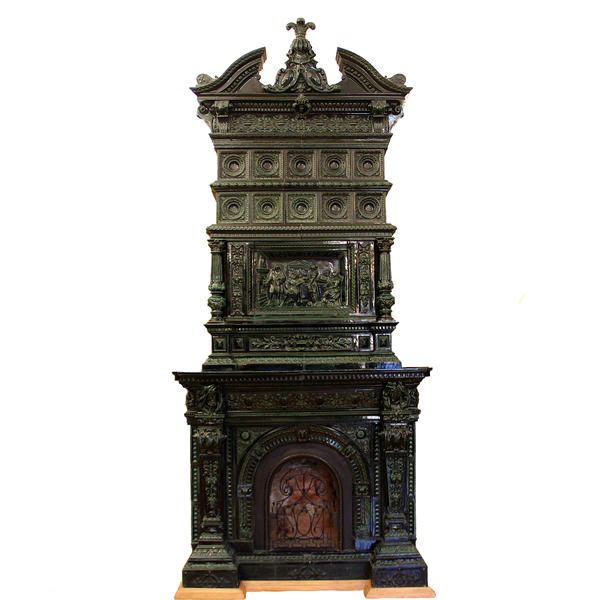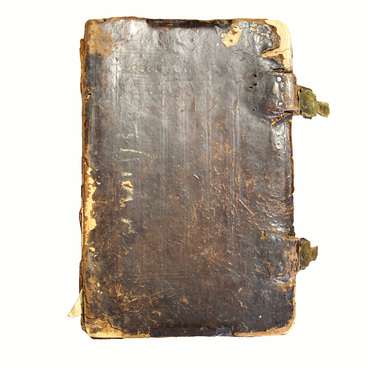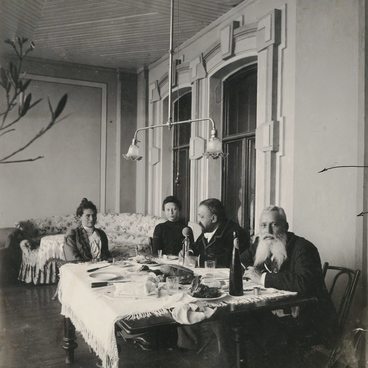The dining room of the mansion has a surviving antique fireplace made in 1898 at the Riga factory Zelm and Boehm. The Clodts, a merchant family, ordered it from the catalogue. The fireplace is made of ceramics and covered with green glazed tiles. The factory bought ready-made moulds for it in Germany from Berlin artist, designer and architect Paul Obst in the second half of the 1890s.
Fireplace
Creation period
1898
Dimensions
354x145x56,5 cm
354х145х56.5 cm
354х145х56.5 cm
Technique
Ceramics
Exhibition
2
Open in app#2
Fireplace
#4
#11
Paul Obst was the leading designer of fireplace stoves and moulds for glazing, which were ordered by factories from around the world. The exterior of the museum fireplace is completely recreated according to one of the designer’s blueprints. The fireplace is more than 3.5 meters high, monochrome and is decorated with convex relief images.
#12
In the centre of the fireplace is the so-called Berlin tile — a pattern made of special ceramic tiles. Its reverse side is made in the form of an open box to be better fastened to walls and fireplaces, and on the front side there is a relief image. When creating this panel, Paul Obst was inspired by Karl Becker’s painting Anton Fugger Burning the Debenture Bonds of Charles V in 1535. The picture was painted in 1866 and is located in the Berlin National Gallery.
#13
Fireplace glazing was usually expensive, so the factory made it to order. The surviving catalogue of Zelm & Boehm presents several design options for the fireplace. The cost of the tiling of the museum fireplace was 145 roubles: for comparison, the construction of the entire mansion cost 5 thousand roubles.
#5
Page from the catalogue of the company Zelm & Boehm
#6
The upper part of the fireplace stove is made in the form of a knight’s helmet – this is one of the decoration options offered by Zelm & Boehm. It is known that another variant of the fireplace is kept on the Belarusian estate of Loshitsy. However, during its restoration, the upper part was replaced with a similar knight helmet. The multi-coloured version of the furnace is located in Vilnius. It is decorated with majolica —tiles made of fired clay with paintings and glazes.
#14
The stove and glazed tile factory Zelm & Boehm opened in 1859. At first, the company focused on the extraction and processing of gypsum stone. Then, under the brand name Zelm & Boehm, they began to produce stove tiles of terracotta — coloured clay of a reddish-brown hue. In 1879, in the Latgale suburb of Riga, the factory launched the production of tiled fireplaces, which spread throughout the Russian Empire, including the Baltic governorates. From the 1880s, Zelm & Boehm products repeatedly won the main prizes of Riga, Nizhny Novgorod, St. Petersburg and Kiev exhibitions.
#15
Zelm and Boehm closed before the Second World War, in 1940. After Latvia became part of the USSR, the company was nationalized.
read morehide
00:00
00:00
1x
Fireplace
Creation period
1898
Dimensions
354x145x56,5 cm
354х145х56.5 cm
354х145х56.5 cm
Technique
Ceramics
Exhibition
2
Open in app
Share




